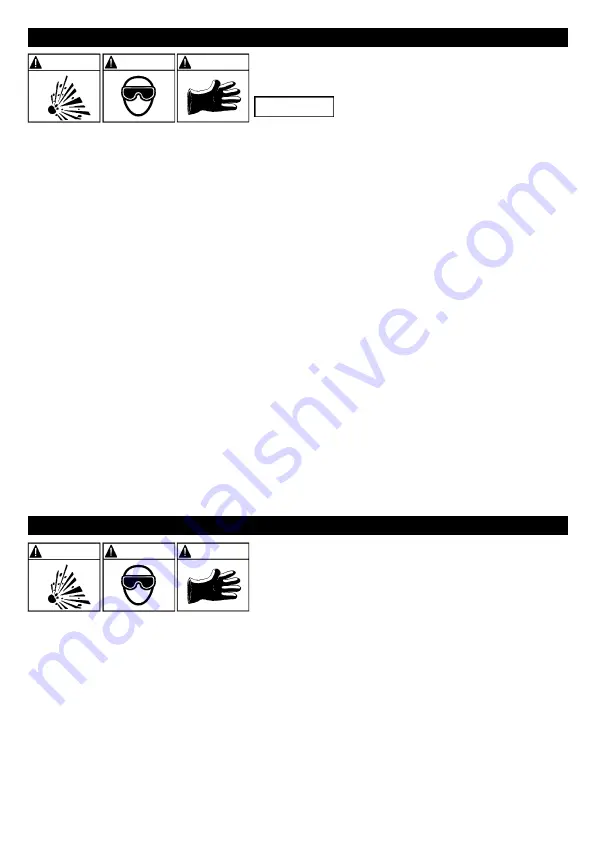
•
6
•
6. FOLLOW THESE STEPS WHEN BATTERY IS INSTALLED IN THE VEHICLE
A SPARK NEAR THE BATTERY MAY CAUSE A
BATTERY EXPLOSION. TO REDUCE THE RISK OF
A SPARK NEAR THE BATTERY:
IMPORTANT
Do not start the vehicle with the charger
connected to the AC outlet, or it may
damage the charger and your vehicle.
6.1
Position the AC and DC cables to reduce the risk of damage by the hood, door and moving
or hot engine parts.
NOTE:
If it is necessary to close the hood during the charging process,
ensure that the hood does not touch the metal part of the battery connectors or cut the
insulation of the cables.
6.2
Stay clear of fan blades, belts, pulleys and other parts that can cause injury.
6.3
Check the polarity of the battery posts. The POSITIVE (POS, P, +) battery post usually has
a larger diameter than the NEGATIVE (NEG, N, -) post.
6.4
Determine which post of the battery is grounded (connected) to the chassis.
T
he battery
terminal not connected to the chassis has to be connected first. The other connection is to
be made to the chassis, remote from the battery and fuel line. See steps 6.5 and 6.6. The
battery charger is then to be connected to the supply mains. The connection to the supply
mains is to be in accordance with the national wiring rules.
6.5
For a negative-grounded vehicle, connect the POSITIVE (RED) connector from the
battery charger to the POSITIVE (POS, P, +) ungrounded post of the battery. Connect
the NEGATIVE (BLACK) connector to the vehicle chassis or engine block away from the
battery. Do not connect the connector to the carburetor, fuel lines or sheet-metal body
parts. Connect to a heavy gauge metal part of the frame or engine block.
6.6
For a positive-grounded vehicle, connect the NEGATIVE (BLACK) connector from the
battery charger to the NEGATIVE (NEG, N, -) ungrounded post of the battery. Connect the
POSITIVE (RED) connector to the vehicle chassis or engine block away from the battery.
Do not connect the connector to the carburetor, fuel lines or sheet-metal body parts.
Connect to a heavy gauge metal part of the frame or engine block.
6.7
Connect charger AC supply cord to electrical outlet.
6.8
A
fter charging, disconnect the battery charger from the supply mains. Then remove the
chassis connection and then the battery connection.
6.9
See
Operating Instructions
for length of charge information.
7. FOLLOW THESE STEPS WHEN BATTERY IS OUTSIDE OF THE VEHICLE
A SPARK NEAR THE BATTERY MAY CAUSE A
BATTERY EXPLOSION. TO REDUCE THE RISK OF
A SPARK NEAR THE BATTERY:
7.1
Check the polarity of the battery posts. The
POSITIVE (POS, P, +) battery post usually has a larger
diameter than the NEGATIVE (NEG, N, -) post.
7.2
Attach at least a 61 cm (24-inch) long 7 AWG (10 mm
2
) insulated battery cable to the
NEGATIVE (NEG, N, -) battery post.
7.3
Connect the POSITIVE (RED) charger connector to the POSITIVE (POS, P, +) post of the
battery.
7.4
Position yourself and the free end of the cable you previously attached to the NEGATIVE
(NEG, N, -) battery post as far away from the battery as possible – then connect the
NEGATIVE (BLACK) charger connector to the free end of the cable.
7.5
Do not face the battery when making the final connection.
7.6
Connect charger AC supply cord to electrical outlet.
7.7
When disconnecting the charger, always do so in the reverse order of the connecting
procedure and break the first connection while as far away from the battery as practical.
7.8
A marine (boat) battery must be removed and charged on shore. To charge it onboard
requires equipment specially designed for marine use.
WARNING
WARNING
WARNING
WARNING
WARNING
WARNING
Summary of Contents for BBCE24-10
Page 110: ...110 BBCE24 10...
Page 111: ...111 1 1 1 1 2 8 1 3 1 4 1 5 SNA Europe 1 6 1 7 ampere AC 8...
Page 112: ...112 1 8 1 9 1 10 1 11 1 13 1 14 46 cm 18 inches AC 1 12 W...
Page 113: ...113 2 2 1 2 2 2 3 2 4 24V AGM 20 230Ah 2 5 2 6 2 7 2 8 2 9 10 2 10...
Page 114: ...114 3 3 1 3 2 3 3 3 4 VRLA 3 5 3 6 3 7 4 4 1 DC 4 2 4 3 4 4 4 5 5 DC 5 1 DC AC 5 2 6 7...
Page 122: ...122 18 230V AC 50Hz 3 2A 24V 10A IP20 19 BBCEC2 BBCER2...
Page 137: ...137 BBCE24 10 WEEE...
Page 138: ...138 1 1 1 1 2 8 1 3 1 4 1 5 SNA Europe 1 6 1 7 8 1 8...
Page 139: ...139 1 9 1 10 1 11 1 13 1 14 46 18 1 12...
Page 140: ...140 2 2 1 2 2 2 3 2 4 AGM 24 20 230 2 5 2 6 2 7 2 8 2 9 10 2 10...
Page 141: ...141 3 3 1 3 2 3 3 3 4 VRLA 3 5 3 6 3 7 4 4 1 4 2 4 3 4 4 4 5 5 5 1 5 2 6 7...
Page 144: ...144 10 1 2 3 4 5 6 7 1 2 3 4 5 6 7 11 5 EN FR ES DE SE ITA 12 BBCE24 10 12 20 230 6 7...
Page 150: ......







































